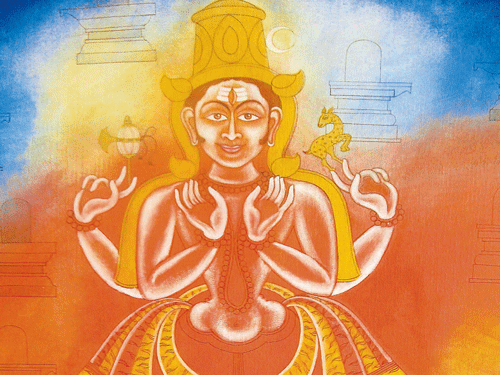
The Surpur style of painting is considered as an offshoot of the Vijayanagara style. The art flourished under the patronage of rulers for about two centuries, particularly during the reign of Immadi Venkatapa Nayaka and Mummadi Venkatapa Nayaka.
The present day Surpur style paintings owe their origin to the murals found in the walls of ruined mansions and temples of Surpur taluk in Yadgir district. The style is similar to the more established Mysore (now Mysuru) and Tanjore styles of painting in terms of the gesso work and the rendering of gold leaf with embedded semi-precious stones. The thematic content adheres to mythology and Vedic themes such as the ashtadikpalas or the guardians of eight directions. While some paintings were made in honour of kings and noblemen, some paintings were used to embellish actual photographs.
Colonel Philip Meadows Taylor, an able administrator and an artist, contributed significantly to preserving these paintings when he served in Surpur as a representative of the Nizam of Hyderabad. He worked in the region from 1842 to 1850. He took many of these works when he returned to England and they are found in the museums of England even now.
This style of art was neglected for long, for almost a century. Since each art form has a unique creation process, in the absence of teachers artists must try to replicate the existing work of art using modern methods and techniques. Such an effort was made by artist Vijay Hagargundgi who is credited with reviving the art and fitting it into the modern medium.
Another family of painters, known as Garudadri Chitralaya, comprising painters like Pulliah, Benakaiah, Banniah and Kamalaiah also worked towards reviving the art on different canvases like wall paintings, paper paintings and paintings on wooden planks.
In Bengaluru, artists Jagannath B Bellad and Jagadish Kamble are continuing the tradition of the Surpur style of painting. Jagannath learnt traditional miniature painting from Vijay Hagargundgi.
Jagannath draws the style and themes for his current work series from the Surpur style, but modifies the scale of drawing to fit into a newer medium and context.
He shifts from the original size of the Surpur painting, which is a miniature scale, and shifts the base from walls and scrolls to canvas. The drawings of gods and goddesses seem to float on the surface of canvas as though their existence is unbound by the abstractly painted, colourful background.
Tones of light and shade used in parts of the body render a sense of volume but at the same time contribute to a sense of translucency to these figures. Lines are what dominate in each work. Thus there is a constant paradoxical situation within the frame on the possibilities of the work.
Another artist who is known for Surpur style paintings is Jagadish Kamble. He is also an accomplished artist in the traditional miniature style. He was introduced to the nearly forgotten traditional form during his high school days. His enthusiasm and curiosity about this style took him to Vijay Hagargundi. The tutelage under him started in 1996 and continued for many years. Jagadish feels he is still to plumb the depths of this style.
Kamble feels that there is enormous scope in innovation within the parameters of the traditional Surpur format and it is in this direction that he hopes to go along in future.